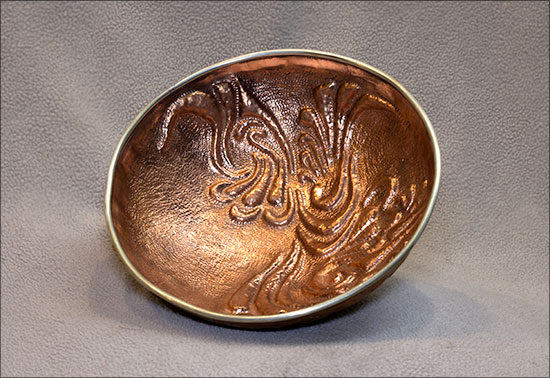Materials: Fine silver, copper
Dimensions: 6" X 6"
a chronicle of the neural degradation that has stricken one I love.
Photo credit: Dan Pogue
David D Pogue
Framingham, MA. USA
In my innocent years I always cherished the time I got to spend in the magic of the forest near my home. I would bide my time while is was in school just for some time to spend in that magical realm. but slowly that magic faded away. I spent my time worrying about whether I could make it in the world and as such I let the world change me. I always was told I had to become a doctor, engineer, or lawyer to make a change in this world. So I Spent years preparing for a career in neuroscience and until one day I realize I had betrayed myself. I let go of that beauty that was important to me in pursuit of a paycheck. I Started doing art because I wanted to find a way to reach back to the beauty I used to see in the world. I create art because I want to break free of the cogs of society and try at least for a moment to express something pure.
These containers and vessels definitely hold their place in the world of stunning art objects as well as in the world of metalsmithing.
Since the dawn of time humans have created containers to hold things that were important to them, from large vessels to hold food and harvests to intimate containers for small precious things. They might hold memories, ashes, medicine, beverage, fruit or food - but all spring from the imagination and skill of the maker. Some have specific religious functions, some are meant for everyday use. When one thinks of a vessel or container the inclination is to think of something with solid walls - yet many of these works involve the exploration of positive and negative space, and the use of negative space to help create the illusion of the wall of the vessel.
As the world’s largest jewelry related internet site, Ganoksin strives to develop exhibitions showcasing work from around the world. This exhibition was open to all metalsmiths, professional and amateur, advanced and beginner. Participants are from The Netherlands, the USA, Canada, Australia, Costa Rica, the United Kingdom, Israel, Hong Kong, Colombia, Romania, Italy, Ireland, Japan, Malaysia and Denmark. While most of the pieces are by an individual metalsmith, some are collaborations, one of three artists spanning 50 years.
In total 319 artists contributed 729 show pieces for the permanent online exhibition.
Objects in the exhibition include boxes, lockets, urns, ash containers, bowls, wine cups, reliquaries, match holders, vases, teapots, pitchers, sugar bowls, baskets, nests, pillboxes, clutches and a range of sculptural forms. A variety of techniques are showcased covering a wide range of metalsmithing techniques. Materials used include everything from gold and silver to less expensive metals. Ornamentation includes the addition of enamel, chasing and repousse’, gemstones and found objects.
The exhibition was curated by Beth Wicker, President of the North Carolina Society of Goldsmiths in the United States, and Adjunct Instructor at Northeastern Technical College in South Carolina. Director of the exhibition is Hanuman Aspler, founder of The Ganoksin Project, the world’s largest internet jewelry site.
